Water restrictions went into effect here in San Diego on June 1. So far there’s a short list of thou-shalt-nots, and the water district has primarily targeted landscape irrigation, the low-hanging fruit, with directives like: no watering between 10 a.m. and 6 p.m., watering only on specified days based on your address, sprinkler-watering limited to no more than 10 minutes, three times a week.
Walking around my neighborhood I can see a lot of people who’ve responded to the call. Some are just beginning to make changes, while others made changes years ago.
I was down a couple streets from my house when I saw this front yard makeover. Simple. Just a few big plants chosen for their countours. This is a house where the modern lines of the house echo the style of the plantings. The sago palm requires some water, but the other plants would do well going dry.
Walking around I saw a number of houses where more drought-tolerant plantings were making their way into the landscape. Each house seemed to have their own take on what a drought-tolerant front yard could look like.
Some relied on hardscape to replace a lawn…
…some went in for lots of mulch instead of a lawn, but not many plants…
…some for mulch with some plants, drought-tolerant or not…
…many of the yards that were reimagined as dry landscapes many years ago seemed to rely on gravel and some plants…
…several used gravel with just a few plants to image a desert theme…
…this one mixed gravel, junipers, and edible landscaping–a fig–right out front…
…many used what I’d consider a contemporary look, employing widely-spaced drought tolerant combining natives or exotics set in mulch or DG…
…here’s another of the style where a few plants are set in the middle of space they’ll never grow into. It’s definitely a look, as well as landscaping that embraces the fact that things don’t need to be densely planted to look good…
…many yards feature some more water-intensive plants mixed in with ones that require a lot of water, a kind of planting that a drip irrigation system can make possible. These people used some roses along with plants that’ll look good with less water.
Looking around you sense that this is a neighborhood in transition. Some people are just letting their lawns go brown. Some may be planning on redoing their plantings. Others are probably just waiting out the water restrictions to go back to their old ways.
Some houses are still attached to their old ways that feature conspicuous water consumption. Maybe at some point its was a status thing, showing everyone that you could spend resources on something that can’t be used. But these days it’s hard not to feel a little hot under the collar when these are resources that are being taken from the rest of us.
Still, before I get overly tough on the neighbors, I want to give people the benefit of the doubt for a while. These are tough economic times. Redoing your landscaping can be an expensive proposition. And there are people for whom dealing with a sprinkler timer would be like asking them to pilot the Space Shuttle. (My father could never figure out his timer.) And there’s a chance that people haven’t heard about the new restrictions.
But there’s one water-user that I’ll call out on the carpet. This is our local shopping center, which presumably is maintained by people who know what they’re doing. But watering the sidewalk and the asphalt…
…and then letting all the water run off into the storm drains, well, that does get my goat. But it’s not like I’m only grousing on a blog they’ll probably never read. They’ve heard from me already, and I hope they’ll get in step with the neighborhood they serve.
But overall I’m pleased. People are getting the message and they’re doing something about it. I think they get a sense that we’re all in this together, and we’ll find ways to deal with this water crisis. Not living in a neighborhood ruled by a homeowner’s association, you can see that we’re all finding different solutions.
Some choices will be better than others from the standpoint of water use, habitat, urban runoff or reducing the heat island effect. Still, it’s encouraging to see people people waking up from this fantasy of a lush, green, subtropical California of endless water resources.


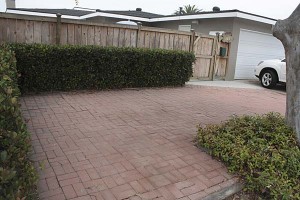

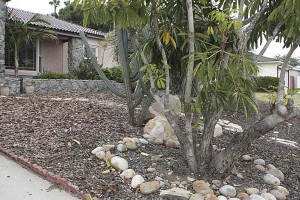
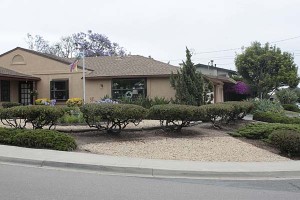

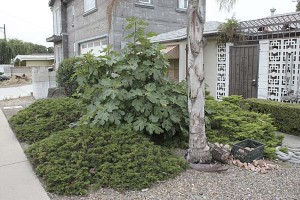


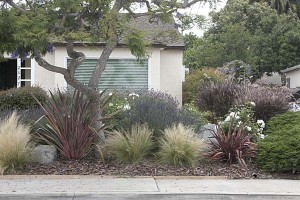
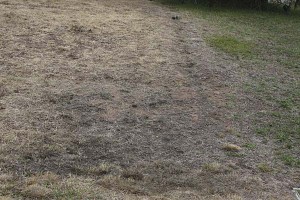
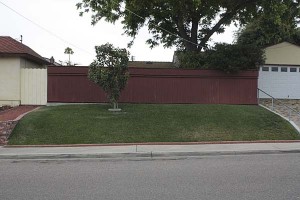

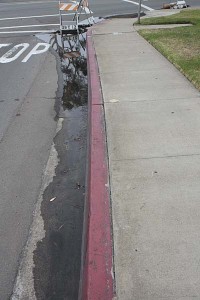
Well done for making your views known to the local shopping center.
I enjoyed interesting tour around your neighborhood.
K
Interesting to see how folks are coping in your neighborhood. Because Bay Area water providers rely on different sources, some were restricting water last year, but have now ceased,while others are just now requiring rationing of varying levels of severity. I dislike driving thru neighborhoods where people just let their lawns go brown, but I know what you mean about tough economic times.
One thing that really disappointed me last year – East Bay Municipal Water District sent out a letter urging all users to forgo planting anything new due to the supplemental water requirements of new plantings – no qualifiers, if, ands or buts. But doesn’t it make more sense to replace a lawn with a low water garden? Even the supplemental water required in the first growing season is less than a lawn, and the pay off is indefinite. (Of course EBMUD probably doesn’t read your blog, so not sure why I’m complaining here, LOL.)
This is a timely post, James. There are probably 4 categories of awareness for water issues which will face scrutiny: 1) the forward thinkers who plan water allocation with city planners and water boards/utilities; 2) Landscape designers and installers who have seen the shortages spoken of and who are adapting accordingly, in surprisingly pretty and practical ways; 3)politicians who hate changing anything at all because it confuses them and who therefore come up with Draconian plans to stop all landscaping; and 4) those in denial whose idea of landscaping is a riding mower.
Hi James, Interesting to hear water restrictions are an issue in San Diego. I live in Melbourne, Australia and we’ve been in drought here for about the last 10 years. Water conservation is a big issue here as well. Drought tolerant plants have also really come back into vogue and rightly so.
Cheers Michael
PS really like some of the gardens, the rocks and stones look great with plants and foliage.
Karen, looking at the houses you’d swear it’s multiple neighborhoods. We seem to be going a stylistic shift as people remodel their homes, all this while people are shifting to gardens that use less water.
Susan, the prohibition against all new landscaping is ridiculous and short-sighted if you ask me! Some of the water agencies around here are giving credits for replacing sprinkler heads while others are giving credits only for installing plastic grass. A neighborhood full of white picket fences and fake turf to me sounds like a version of hell…
Steve, I noticed that you just posted on a similar topic. The confusion you mention is tough to get around. What is the public to think when one agency tells them to replace their sprinklers while another tells them to plant plastic lawns? The conspiracy theorist in my head wonders if the lawnmower manufacturers and lawn-care lobby are contributing to the campaigns of the politicians who are blocking progress on this issue.
Michael, thanks for stopping by. Your drought has made the news up here, and I think some of Australia’s solutions can teach us a few things. We’ve definitely been seeing more mediterranean-climate Australian plants being used in our home landscapes.
One thing I miss about living in a suburban neighborhood – walking my dog around and looking at all the different things people do with their yards. I sometimes take a trip into town to do some suburban hiking, just to have that pleasure. In Scotts Valley and Santa Cruz neighborhoods I see a similar transitional state – we’re not so dry and hot as you are in San Diego. As befits a forested region, I see use of wood mulch to space the plantings more than gravel type mulch, with exceptions. Dry stream bed type features are also attractive and used a fair bit.
Country Mouse, I can see how wood mulch would be a more popular and appropriate option for where you are–A yard of stones in Santa Cruz might feel like a landscaped gravel pit. Rebecca Solnit has written often and interestingly about walking, including her book Wanderlust.
This is fascinating, not just because I have often wondered about your local climate and what is possible in it, but also the whole issue of water conservation and how serious it is. I live in the UK which is known jokily worldwide as cloudy and damp, and yet we suffer our droughts too. I got into the habit of using grey water for the garden years ago wether we are having restrictions at the time or not, and it always amazes me that even in a country like ours where we could have plentiful water with careful management and everyone doing their bit, this only ever happens when hosepipe bans come in by which time it’s obviously too late. People just don’t seem to get that water is precious, or believe that it could run out.